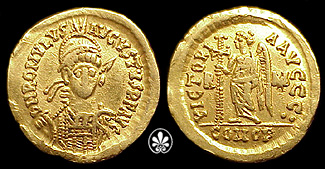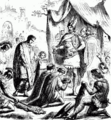Romulus Augustulus facts for kids
Quick facts for kids Romulus Augustus |
|||||
|---|---|---|---|---|---|
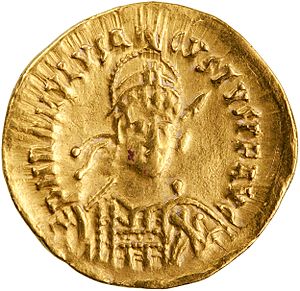
Solidus of Romulus Augustus, marked:
dn romvlvs avgvstvs p f avg |
|||||
| Roman emperor of the West (unrecognised in the East) |
|||||
| Reign | 31 October 475 – 4 September 476 | ||||
| Predecessor | Julius Nepos | ||||
| Born | c. 461/465 Pannonia |
||||
| Died | after 511 Castellum Lucullanum |
||||
|
|||||
| Father | Orestes | ||||
| Mother | Barbaria | ||||
Romulus Augustus (around 461/465 – after 511) was a Roman emperor who ruled the Western Roman Empire for a very short time. He was emperor from October 31, 475, to September 4, 476. People often called him Augustulus, which means "little Augustus". This nickname was used because he was very young when he became emperor.
Romulus was put on the throne by his father, Orestes. His father was a powerful general known as the magister militum (master of soldiers). Because Romulus was still a child, he was mostly a figurehead. This means his father made all the important decisions. After only ten months, a barbarian general named Odoacer defeated and killed Orestes. Odoacer then removed Romulus from power.
Since Odoacer did not name a new emperor, Romulus is usually seen as the last Western Roman emperor. His removal from power is often considered the end of the Western Roman Empire as a political state. This event is also sometimes used by historians to mark the change from ancient times to the Middle Ages. Very few records exist from Romulus's short rule. We don't know of any major laws or policies he made. This makes him seem like a minor figure in history. Romulus's family, including his father, came from a Roman province called Pannonia. Many of his relatives were soldiers.
Contents
Becoming Emperor
How Romulus Augustus Came to Power
Romulus Augustus became emperor after his father, Orestes, took power from the previous emperor, Julius Nepos. Nepos had been emperor for less than a year. In 475, Orestes was made a high-ranking official and commander of the army. His job was to lead soldiers against some rebellious barbarian groups in Gaul.
However, Orestes betrayed Nepos. He marched his army to Ravenna, which was the capital of the Western Roman Empire. On August 28, 475, Orestes entered Ravenna. Emperor Nepos had to escape across the Adriatic Sea to a place called Dalmatia. He continued to claim he was the emperor from there.
After Nepos fled, there was no emperor in the west for two months. Then, on October 31, 475, Romulus was made emperor by his father. Romulus was very young, perhaps only ten years old. He was the last emperor to be named in the Western Roman Empire. His father, Orestes, kept his powerful military position and truly ran the empire. The Eastern Roman emperor, Zeno, never recognized Romulus as the true emperor. This was because Zeno still supported Julius Nepos.
The Roman Empire's Situation
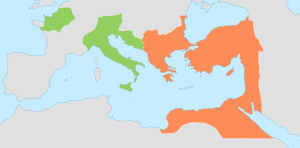
By the 5th century, the Roman Empire had become too big for one ruler. It was split into two parts: the Western Roman Empire and the Eastern Roman Empire. Even though they had two rulers, the Romans still thought of it as one empire.
The Western Roman Empire faced huge problems. It was mostly rural, with fewer people and a weaker economy than the East. Many Germanic barbarian groups invaded and settled in the west. This made things even harder.
In 410, the Visigoths attacked and looted Rome. In 455, Rome was attacked again by the Vandals. The Roman army started to rely more and more on barbarian soldiers. Powerful barbarian generals began to control the empire by putting their own "puppet emperors" on the throne. In the 20 years before Romulus Augustus, eight different emperors ruled in the west. By 475, the Western Empire was in a very bad state. Outside of Italy, it had very little control.
End of His Reign
The Fall of Romulus Augustus
Problems with the Western Roman army, which was mostly made up of barbarian allied troops called foederati, grew worse in the 470s. These problems had allowed Orestes to remove Julius Nepos from power.
In 476, the barbarian foederati in Italy demanded land to settle on. Orestes refused their request. The leader of these barbarian soldiers was Odoacer. Odoacer was a barbarian officer whose father had once worked with Orestes.
On August 28, 476, Odoacer defeated Orestes in a battle. He captured Orestes and had him killed. A few days later, on September 4, Odoacer captured Ravenna, the capital. Romulus was captured and removed from power. Odoacer then took control of Italy and became its first king.
Odoacer sent Romulus's imperial symbols (like his crown and robes) to Emperor Zeno in the East. He promised loyalty to Zeno. This meant there would be no more emperors in the west. Some historians believe Odoacer might have even forced Romulus to send a "letter of resignation" to Zeno. This letter would have said that the Roman Empire only needed one emperor, ruling from Constantinople. Zeno gave Odoacer an important title, but he also told Odoacer to accept Julius Nepos back as emperor in Italy. Odoacer agreed to this in name, but Nepos never actually returned to rule Italy.
Life After Being Emperor
Romulus Augustus's Later Life
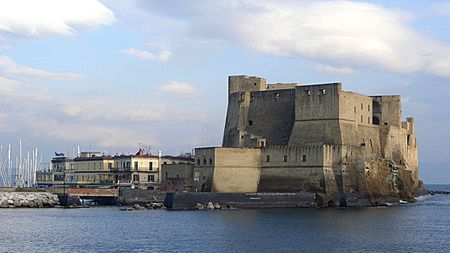
Odoacer decided to spare Romulus's life because of his "youth and beauty." Romulus was given a yearly payment of 6,000 solidi, which was a lot of money, like a wealthy senator's income. He was also given a large estate in Campania, near Naples. This estate was called the castellum Lucullanum, and it's known today as Castel dell'Ovo. It was originally built by a famous Roman general named Lucius Licinius Lucullus. This place had even been a retirement home for Tiberius, Rome's second emperor. By Romulus's time, it was likely a strong fortress. Romulus moved there with many of his remaining family members and servants.
We don't know much for sure about Romulus's life after he was deposed. He might have been alive as late as 507 or 511. Around that time, Theodoric the Great, who took over as king of Italy after Odoacer, wrote a letter to a "Romulus." This letter confirmed a payment given to Romulus and his mother. Historians think this "Romulus" was likely Romulus Augustus. The letter didn't give him any special titles, which was unusual for letters from a king. This might be because they weren't sure how to address a former emperor. If it was him, it suggests he and his family had to make new financial arrangements with the new king. Romulus likely died before the mid-530s, as he is not mentioned in later accounts of wars in Italy.
Romulus might have helped start a monastery at castellum Lucullanum in the late 480s or early 490s. This monastery was dedicated to Saint Severinus of Noricum. A Roman noblewoman named Barbaria, who might have been Romulus's mother, also helped with the monastery. This monastery became important and was active until the 10th century.
His Place in History
The Legacy of Romulus Augustus
Very few records exist about Romulus's time as emperor. We don't know what policies he might have tried to put in place. The lack of information, few coins, and no known important writings or laws from him make him seem like a very minor figure. Some historians have even called him "perhaps the least significant" of the short-lived emperors at the end of the Western Roman Empire.
Romulus Augustus is usually seen as the last Western Roman emperor. His removal from power is often considered the end of the Western Roman Empire as a political state. This event is also one of the most common dates historians use to mark the change from ancient times to the Middle Ages.
His importance as the "last emperor" comes not only from being the last one named in the west. It also comes from the interesting fact that his name combined Romulus, the founder of Rome, and Augustus, the first Roman emperor. Many historians have noted this coincidence.
Was He Truly the Last Emperor?
Some modern experts question whether Romulus was truly the last Western Roman emperor. They point to Julius Nepos as the actual last emperor. Even though Nepos never got Italy back, he continued to rule in Dalmatia. He had support from the Eastern Roman emperor Zeno and was even recognized by Odoacer in name. Nepos ruled until he was murdered in 480. During Romulus's short reign, the Eastern Roman Empire never recognized him. They continued to see Nepos as the rightful Western emperor.
Even after Nepos, some others tried to claim the title of Western emperor. For example, a Moorish leader named Masties in North Africa claimed to be an emperor from about 477 to 516. In Spain, two Roman leaders, Burdunellus (in 496) and Petrus (in 506), also tried to claim imperial power.
However, the idea that Romulus Augustus was the last emperor of the Western Empire started very early. Eastern Roman historians in the early 6th century already thought of him this way. For example, a writer named Marcellinus Comes wrote about Romulus: "The Western Roman Empire... perished with this Romulus Augustus." Other Eastern Roman writers also saw him as the last legitimate ruler in the west.
Images for kids
-
19th-century illustration of Romulus Augustus surrendering his crown in front of Odoacer
-
Romulus Augustus' family originated in Pannonia
See also
 In Spanish: Rómulo Augústulo para niños
In Spanish: Rómulo Augústulo para niños


